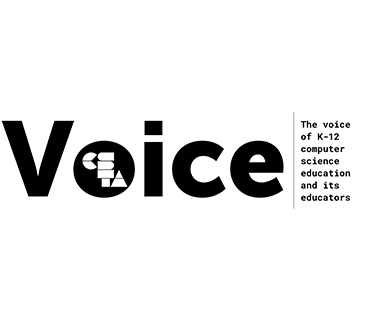“Computer science is! Computer science is! Using the power of computers to solve our problems and express ourselves!”
Full Story
“Computer science is! Computer science is! Using the power of computers to solve our problems and express ourselves!” I look left to right, making eye contact with individual students as we rhythmically flex our muscles, tap our heads, and extend a fluid arm forward along with the chant. These kindergarteners are ready to begin computer science (CS) class. The kindergarteners in your district are, too!
In 2015, San Francisco’s Board of Education resolved to expand CS to all schools and all students pre-kindergarten through 12th grade. Since that resolution, our strategy has been to start in the middle and expand outwards. Four years later, middle school is stable and high school is expanding with an art-centric pilot. Now, our gaze is turning to elementary and early childhood.
Last year was my first year as an itinerant CS specialist. I served at two elementary school sites and each site had four classes per grade level. At the time, we had two sets of curricula: one for K-2 and another for 3-5. That means I taught every K-2 lesson twelve times! To challenge grade levels appropriately, I increased the rigor and depth of second-grade lessons and paired lessons down to their essentials for K. It was clear to me, even after making the adjustments, that kindergarten, and eventually pre-kindergarten, CS would need to look different; they would need their own developmentally-appropriate curricula.
That summer, I applied to earn an Early Childhood Technology Certificate through Tufts University. My professor, Dr. Amanda Sullivan, shared alarming research that found children as early as four years old form stereotypes about gender and gender roles. Sullivan’s own research with Tufts University sought-out to find an intervention for young girls and their developing attitudes towards STEM careers. She concluded that prior to beginning a robotics curriculum, more boys than girls expressed interest in being an engineer when they grew up. Later, after all, students engaged in a developmentally appropriate gender-neutral robotics curriculum, the girls’ interest in engineering elevated and was equal with the boys.
Educators, districts, and states have a time-sensitive challenge to introduce CS to girls and underrepresented populations at the earliest ages. We can influence a child’s belief as to who can and who will be successful at CS by writing research-informed curriculum, with a cultural, gender, and stereotype-informed lens.
I clenched my fist and brought it close to my chest. “A lot of love and a lot of research went into writing this curriculum.” With a click, I advanced my slide deck for over 30 elementary CS educators and revealed the Tufts DevTech Research Group’s logo, a Universal Design for Learning (UDL) infographic, and the covers of three books: Zaretta Hammond’s Culturally Responsive Teaching and the Brain, Marina Ber’s Coding as a Playground, and Mitch Resnick’s Lifelong Kindergarten.
Now, I design and facilitate research-based CS experiences for early childhood and kindergarten. Between June and October 2018, I wrote and released twenty lessons for kindergarten separated into three units: Unplugged Activities, Blue-Bots, and Scratch Jr. on our CSinSF.org website. To date, these kindergarten lessons have garnered over 20,300 pageviews from more than 4,100 unique visitors hailing from 82 countries. Most page views were of the first six unplugged lessons. People are curious; what can a strong, standards-based, stereotype-smashing first interaction with CS look like?
They’re constructionist. Seymour Papert posited children learn best when they are actively constructing a public artifact; the artifact is the vehicle by which the learner learns and reflects upon their own thinking. What does that mean? Each lesson invites students to create a unique physical manifestation of their thought process, then we build-in intentional time for children to talk about their creations with peers and, occasionally, the whole group:
Lesson 1: Students build a computer out of materials they choose.
Lesson 2: Students design a computer, focusing on its inputs and outputs.
Lesson 3: Students choreograph multiple-move handshakes and record the sequences using icons and drawings.
Lesson 4: Students draw three pictures that have similarities and differences among them.
Lesson 5: Students decompose and recompose squares to make robot art.
Lesson 6: Students remix origami algorithms to create new shapes.
And there’s more. If you, your school, or your district wants to find out more about introducing computational thinking in the early grades, join me at CSTA 2019 Tuesday, July 9, from 3:30-4:30 p.m. for a hands-on dive deep into lessons 3 and 6. And yes, we’ll learn the chant!
Additional Resources
- SFUSD’s Red Level (Kindergarten) Curriculum
- Constructionism from Future of Learning Group, MIT Media Labratory
- Sullivan, A. & Bers, M.U. Int J Technol Des Educ (2018)
About the Author
Michelle G. Lee is a Computer Science Content Specialist for the San Francisco Unified School District. She will present at CSTA 2019 on Tuesday, July 9, in the session Teaching Computational Thinking in Early Elementary. She delivered CSTA 2018’s closing keynote and tweets @michellegleeCS. Her team is #CSinSF.

